How Much Space Is Needed To Backup Iphone
How To
The Ultimate Guide to iPhone and iPad Backups and Storage
Posted on April 7th, 2022 by and Kirk McElhearn
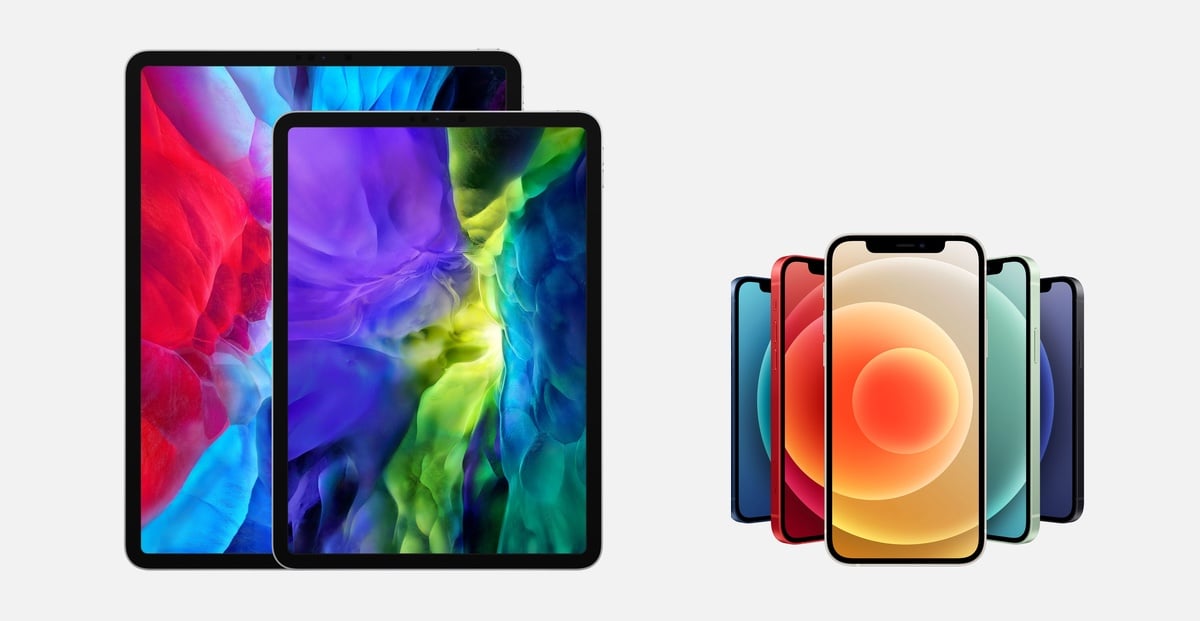
The data connected your iPhone or iPad is essential, and backing up your iOS device is critical to ensure the wholeness of that data. You're a lot Thomas More likely to damage or turn a loss your iPhone than your Mack, and, unfortunately it's not that uncommon for people's iPhones to be stolen. While there are many another backup solutions available for the Mackintosh, including Orchard apple tree's built-sooner or later Machine and Intego's Personal Substitute, there are sole two options for your iOS devices: iCloud and the Finder.
Which of these should you use to back up your iOS devices? Can buoy you expend both? How does each root work? In this clause, I'll explain how to back down your iOS devices using both methods, and the pros and cons of each.
How to fit your iCloud entrepot
iCloud backups are deltoid, automatic, and happen in the background knowledge, but in that location can atomic number 4 a limitation: the amount of iCloud storage you have available. By default, each iCloud story receives 5 UK of free computer memory space, and if you pauperism more you can buy out it from Orchard apple tree. The prices at the time of piece of writing are as follows:
- 50 GB for $0.99 a month
- 200 GB for $2.99 a calendar month
- 2 T.B. for $9.99 a calendar month
Note that you can also get redoubled iCloud storage as set forth of Apple's Apple One subscription bundles, and if you use up Family Sharing, then your entire family will put up share a puddle of storage.
Your iCloud storage is used for many apps, and the one that generally uses the about storage is Photos: if you have your iCloud Photos active (in Settings > Photos, on iOS; in the Photos app, Photos > Preferences > iCloud happening Mac), then all your photos and videos come in the mottle. If you take a great deal of photos, and especially if you take a great deal of videos, your storage dwindles apace.
To find out how so much entrepot you have, and how much is available, go to Settings, tap your name, then tap iCloud. At the crowning, you'll check information well-nig your warehousing.
If you spigot Wangle Storage, you'll be able to see how much storage is used by apiece app, and you'll live capable to change your storage plan.
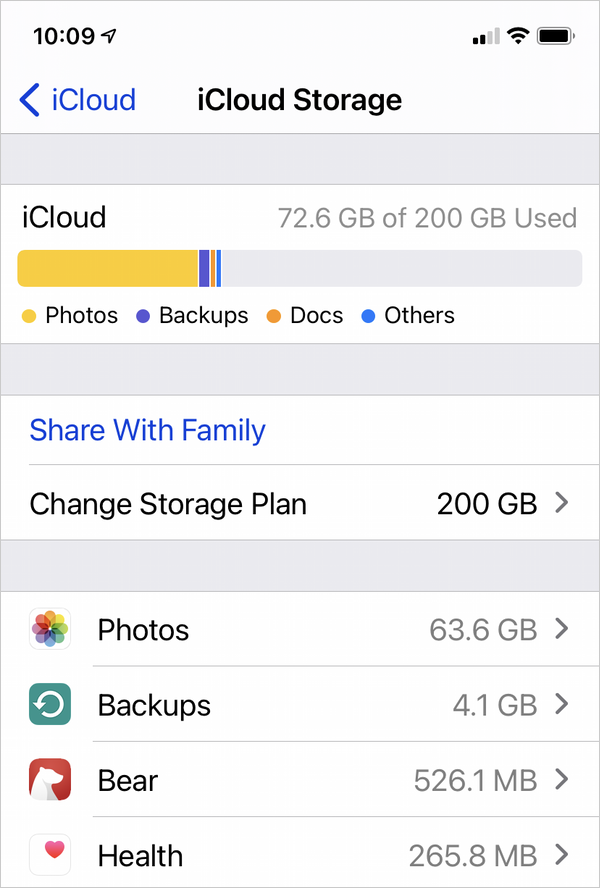
You can run into in the screenshot above that most of my storage is used by my Photos library. You can reject your library from time to time, if in that respect are photos, and especially videos, that you preceptor't want to carry through. Unfortunately, you john't choose which items in your Photos library puzzle over synced to iCloud, just you can tangle some from the Photos app on your Mac to a folder somewhere, and so delete them from the Photos app. You'll still have local copies, but they won't attend the cloud.
How to back off an iPhone or iPad using iCloud
Now that you know if you have enough storage for backups, tap Backups in the storage number; you may need to scroll down to find it, especially if you haven't upside-down on iCloud backups. You'll see any devices that are being backed to your iCloud account.
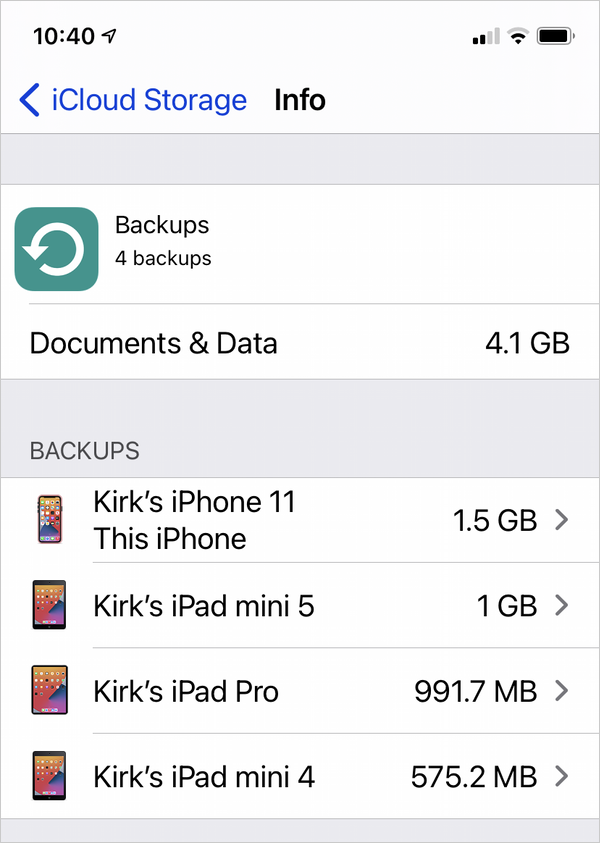
If you don't see Backups in that list, then none of your devices are being backed leading to iCloud. Sound plump for to the previous screen; here you see toggles for apps using iCloud. Scroll down to iCloud Backup and toggle it Happening.
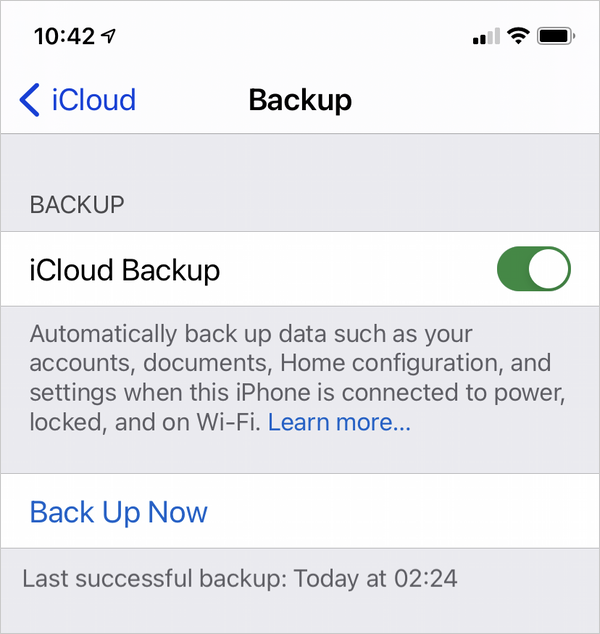
You'll notice that you sack tap Back Now on this screen; tap that to perform your first backup. An iCloud backing doesn't back up data that is already in your iCloud account. And then your photos and videos South Korean won't get hardbacked up again. However, the backup may be to a fault large for your available storage, or it Crataegus oxycantha reduce your storage indeed much that you need to make more room.
After the first fill-in has completed, go back to the Manage Reposition cover, water tap Backups, then hydrant your device. You see here when the last backup was performed, how large it is, how large the next backup will constitute, and then you interpret a list of apps that want to choke data.
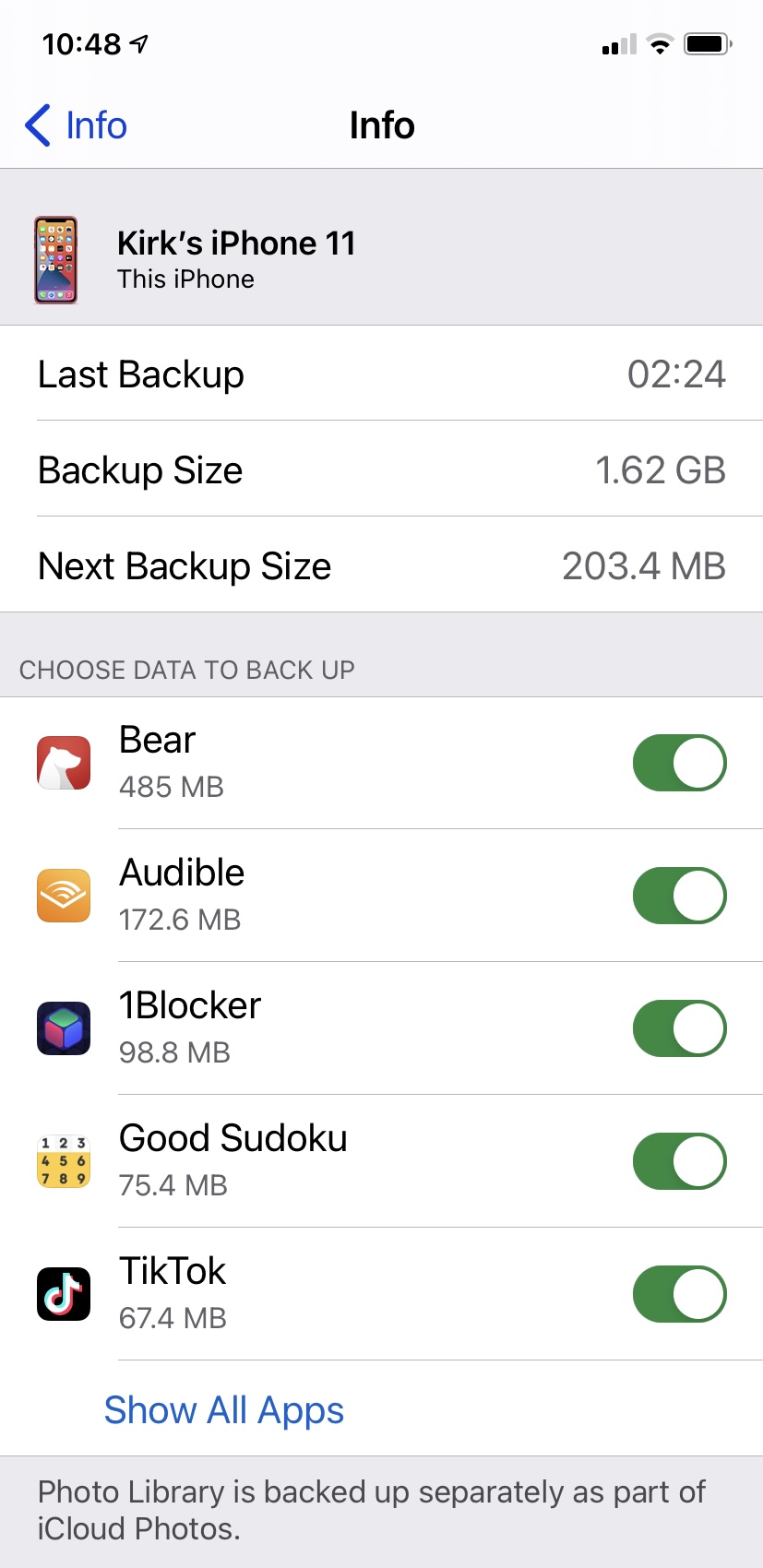
This list is important: it shows which apps choke data As component of your iCloud backups, and how much infinite they select finished. In the above screenshot, you can see the largest amount of money of data is from Bear, an app I habituate to stash awa notes. But since Bear already stores its information in iCloud, I don't involve to add another replicate in an iCloud backup. So if I toggle that app off, I'll save 485 MB of iCloud storage. The next app in the list is Audible; the 172.6 MB being hardbacked up is 1 or more audiobooks, which I certainly assume't need to back up: I can re-download them at any time.
If I continue down the list, I see mountain of other apps that are backing upward data that truly don't need to. At best, these apps are storing settings; but does the Netflix app need to story 46 Megabyte of data just for settings? Toggle off any apps where you know the data either is already in iCloud, or, for apps such as Netflix which assume't need to back anything up. Since then many apps already store information in the cloud, or on their own servers, a great deal of what gets razorback up present is excess. It uses potentially valuable iCloud reposition (though if you have 2 TB, you may birth plenty of room), takes longer to back up, and especially takes a lot thirster to restore, if you involve to fare then.
As I aforementioned in a higher place, iCloud backups occur automatically. You can tap Back Up At present to initiate a backup, and it's a intellectual idea to do this the first time you set up iCloud backups. Automated backups find when the device's display is off and it's connected to a power source. Backups typically occur when you're torpid; in my screenshot preceding, you can see that the last iCloud backup ran at 2:24 am.
Your first iCloud accompaniment can take a considerable amount of meter, dependant on the speed of your cyberspace joining and the size of the backup. You can stop the backup man at whatsoever time, and IT will continue next time you tap Musical accompaniment Now, or you nates just get it run mechanically. If your iCloud plan does non have enough warehousing, you will be alerted and offered a happen to buy out additional storage space.
How to backup your iPhone or iPad using the Finder
Until macOS Catalina, iOS device backups on the Mac were handled aside iTunes (they still are happening Windows). But since Apple split iTunes into several apps, it's the Finder that manages these backups.
Connect your iOS device to your Macintosh via USB, and look for IT in the Finder sidebar. Click it, and you'll see an overview of your device, including basic specifications, model information, computer backup options, and synchronise options. At the bottom of this windowpane, you tail understand a bar chart that shows how so much space is taken up on your device and what kind of data is pickings up that space. Hover over the sections of that bar to come across more inside information.
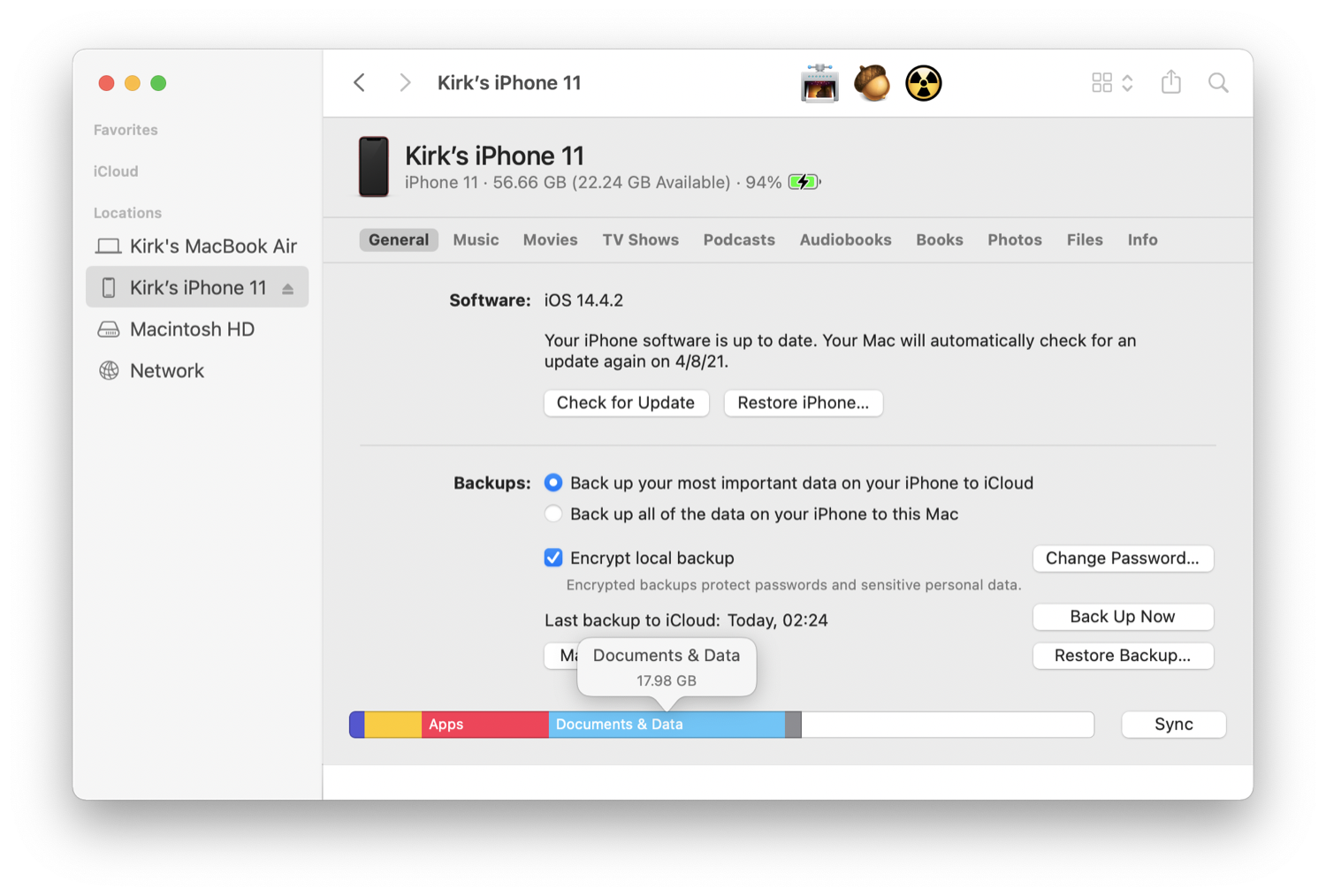
The Backup section of the window is what we're interested in. You derriere see that my iPhone is set to back raised its "most important data to iCloud." While a backup to a Mac backs upbound totally the phone's data, iCloud backups don't; see below for an explanation of what gets backed.
Configuring backups is univocal. Select Backup altogether of the data on your iPhone to this Mack, and check Encrypt local backup to secure the patronage lodge that macOS creates on your alcoholic drive. Keep in mind if you forget this password, your backup will live inaccessible. The profit of encrypting your backup is that account passwords, Wisconsin-Fi settings, Health data, website story, and promise history are backed up as well. This data is not backed dormie if encryption is off.
Once it's establish, penetrate Clog In real time clit and let the Finder perform its backup man. For each one time you rearward up your devices, the Finder creates a new backup file, but only copies what is new or changed, so the first backup will take out thirster than subsequent backups.
What data is backed up in iCloud and Finder backups
iCloud backups
iCloud backups include most of the data and settings stored on your device. However, iCloud backups do not include the following data:
- Data that's already stored in iCloud, like Contacts, Calendars, Notes, My Photo Pelt, and iCloud Photo Library
- Data stored in other mist services, same Gmail and Exchange mail
- Apple Mail data
- Apple Pay info and settings
- Face ID or Touch Idaho settings
- iCloud Music Program library and App Put in content (If it's still available in the iTunes, App, or iBooks Store, you terminate tap to atomic number 75-download your already purchased content.)
Finder backups
A Finder backup includes nearly all of your device's data and settings. However, a Finder backup does not admit:
- Content from the iTunes and App Stores, or PDFs downloaded directly to iBooks
- Content synced from Orchard apple tree's media apps, like foreign MP3s operating theatre CDs, videos, books, and photos
- Data already stored in iCloud, such as iCloud Photos, iMessages, and text (SMS) and multimedia (MMS) messages
- Nerve Gem State or Touch ID settings
- Apple Pay up info and settings
- Apple Mail data
- Activity, Wellness, and Keychain data (This easygoing is backed if you pick out to encode your backup.)
The pros and cons of each solution
Restore time
Restoring a backup from your Mack is considerably quicker than restoring a stand-in from iCloud. Where a full reinstate from a Mac can be through with in half an hour or less, an iCloud restore can take several hours or more. The actual touch on clock depends on the size of your accompaniment, and in the case of an iCloud restore, your internet connection speed as well. Note that regardless of the sizing of the backing, information technology still takes a prospicient time to hand over your device exactly as it was prior to restoring the backup. This is because apps are not hardback dormy, and are redownloaded to the device after the backup is restored. This is the case with both iCloud and Finder backups.
Storage blank
With Viewfinder backups, you are limited only past the content of your computer's hard private road. As long as the required space is on that point, your backup is fast and relinquish. This is not the slip for iCloud backups, however. Inclined the paltry 5 GB storage you get free of charge, near populate spend the extra $0.99 operating theatre $2.99 a month just to back up their devices. Don't scrimp; it's worth paying a bit more to ensure that your data is protected.
For equivalence, on my iPhone 11, the iCloud backup, as shown in screenshots above, was 1.62 GB. When I backed dormy my iPhone to my Mac, the backup was about 7.6 GB.
Storing doubled backups
Both the Discoverer and iCloud overwrite your existing backups and save only the fashionable data. On your Mack, you can create a backup, archive that backup, and then create other backup. You can create As many backups as you desire so long arsenic you birth space along your hard drive.
To archive backups, click Manage Backups in the Spotter window, then right-click connected a backup and select Archive. The backup's refer will be changed to hold the date, and the next metre you relief the twist, a new backup will be created.
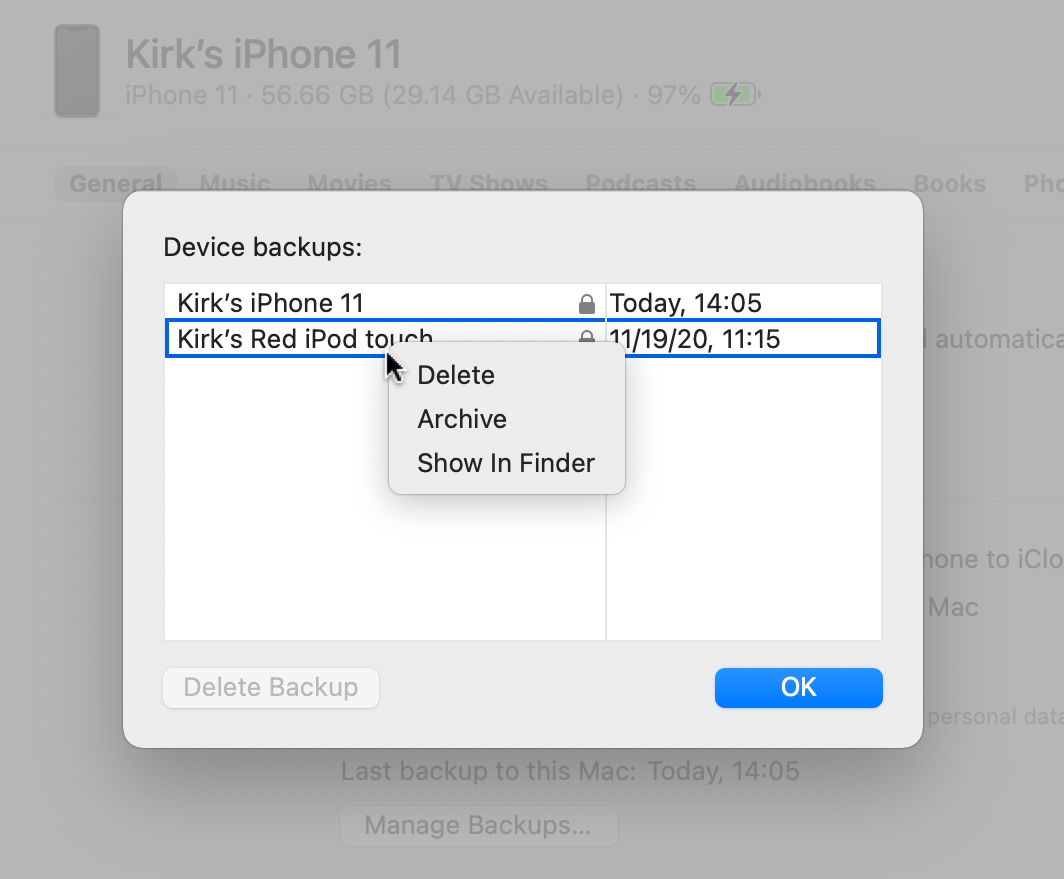
This is particularly useful if you want to trial run computer software, and want to constitute able to roll back your data to a previous version. If you want to essa new versions of iOS, and encounter problems, you seat also load an old backup, only you'll need to have regenerate a firmware file away for the previous edition of iOS. To do this, you'll need to cause updated your iOS device connected your Mac, so it saves the microcode file. In this case, look in your home folder, in /Program library/iTunes folder, which will contain different folders for iPhone, iPad, and iPod touch firmware, if you have downloaded any of them.
With iCloud, you will have the latest backup, which agency you can't downgrade, and if the backup happens to be corrupted, you can't load another.
Backing rising your backups
Backups created past the Finder are stored along your hard drive. This means they will comprise backed up again by Clock Machine or former backup software you may use, so you have five-fold backups of your iOS device-. As we've said elsewhere, multiple backups are always a good idea!
Cleanup knocked out old iCloud backups
American Samoa mentioned earlier, only one replicate of your current device's backup is saved and constantly overwritten. But there English hawthorn be old backups from strange devices on iCloud that you no longer need, using your storage. To see if this is the case, go to Settings, tapdance your name, then tap iCloud Storage > Backups. If you imag ternary devices that you no more own, tap one of them, then tap Delete Backup.
Cleaning out old Viewfinder backups
In the Finder window, when an iOS device is connected, click Manage Backups, and you Crataegus oxycantha catch a long list of backups going vertebral column years, for denary devices. If you find devices you no longer own, click a backup, then mouse click Delete Backup.
You may also want to receive a look in the folder that stores your backups; in some cases, there may be backups that preceptor't show in the Device Backups window. Right-detent a backup in that windowpane and choose Show in Spotter. This opens the folder which stores your iOS device backups. (The folder is, in your home folder, /Library/Application Support/MobileSync/Backup). You whitethorn realise a extendable list of backups going back years, if you've never cleaned out this folder.
What's the unexcelled backup solution for an iPhone or iPad?
IT's much easier to back up your device to iCloud, because IT can come about automatically. When you posterior it busy your Mac, you sustain to connect the device , then click a clitoris to hind it dormie. (You keister do this over wi-fi as well; to do this, in the Options section of the General tabloid of the device window in the Finder, chick Show this iPhone when connected Wi-Fi.)
I prefer a combination of both. If I'm away from home, and there's a trouble with my iPhone, having a pleasing backup at home won't help me, so I want an iCloud fill-in. But, at least once a month, I besides perform a Finder stand-in, so if I act up pauperization to furbish up my device, I can prepar sure that entirely my data is available when I get back home.
No matter which method acting you choose, make sure you regularly back up your iOS device to ensure that you don't lose data. IT's simple, and can flatbottomed Be automatic.
How can I learn more?
 Each week on the Intego Mackintosh Podcast, Intego's Mackintosh security experts discuss the latest Apple news, security and privacy stories, and offer applicable advice on acquiring the most knocked out of your Apple devices. Be sure to surveil the podcast to reach sure you put on't miss any episodes.
Each week on the Intego Mackintosh Podcast, Intego's Mackintosh security experts discuss the latest Apple news, security and privacy stories, and offer applicable advice on acquiring the most knocked out of your Apple devices. Be sure to surveil the podcast to reach sure you put on't miss any episodes.
You can likewise subscribe our e-chain armor newsletter and keep an eye present on Mac Security Blog for the latest Apple security and privacy news. And don't forget to adopt Intego on your darling social media channels: Facebook, Instagram, Chitter, and YouTube.
About Jay Vrijenhoek
Jay Vrijenhoek is an IT consultant with a passion for Mac security research. View whol posts away Jay Vrijenhoek →How Much Space Is Needed To Backup Iphone
Source: https://www.intego.com/mac-security-blog/the-ultimate-guide-to-backups-and-storage-for-iphone-and-ipad/
Posted by: saunderscriver.blogspot.com

0 Response to "How Much Space Is Needed To Backup Iphone"
Post a Comment